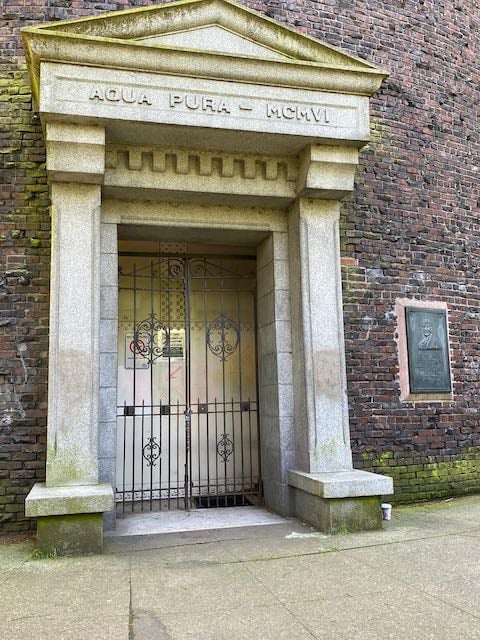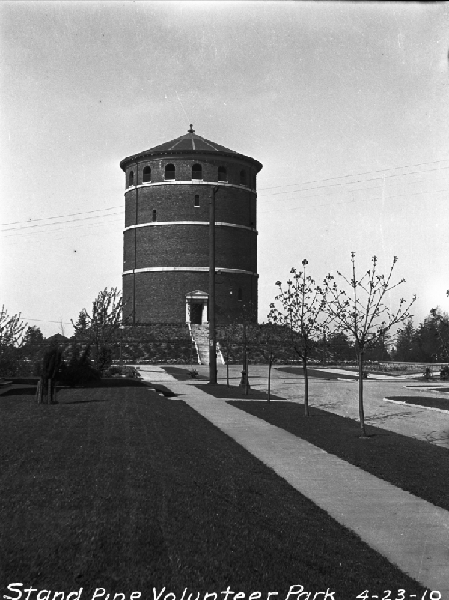An Iconic Landmark Worth Exploring
Nestled within Seattle’s picturesque Volunteer Park, the Volunteer Park Water Tower stands tall as a testament to the city’s remarkable history and architectural prowess.
This iconic landmark, with its distinctive classical architecture has captivated visitors for over a century, offering breathtaking panoramic views of the city and the surrounding natural beauty. Originally built in 1906 as part of the Olmsted Brothers’ park design, the Volunteer Park Water Tower served as a vital component of Seattle’s water system, providing much-needed water pressure to the area.
Over the years, it has evolved into not only an essential piece of infrastructure but also a beloved symbol of the city’s rich heritage. Stepping inside the tower is like taking a journey through time. The historic charm is palpable as you ascend the spiral staircase, passing beautiful stained glass windows and intricate brickwork.
On reaching the observation deck, you are rewarded with breathtaking 360-degree views that stretch from the Cascade Mountains to the downtown skyline and even as far as Puget Sound. Whether you’re a history enthusiast, architecture aficionado, or simply seeking a unique vantage point, the Volunteer Park Water Tower is a must-visit destination. It’s an opportunity to connect with Seattle’s past while immersing yourself in the beauty of its present.
Overview
Seattle’s beloved Volunteer Park Water Tower rises to 520 feet above sea level, the highest point on Capitol Hill. Climb to the top where you can enjoy sweeping views of the Puget Sound region. Sixteen windows around the perimeter provide 360-degrees of viewing beauty! While trees now block some of the view, the Parks Department is planning a renovation project when funds are available.
At the base, a circular walking path takes you around the Water Tower. It is the first thing visitors see when entering from Millionaire’s Row on 14th Avenue East.
Location of the Tower
The Water Tower is located in the southeast corner of Volunteer Park where it serves as a traffic circle. Anchoring the Concourse, the Water Tower sits east of the Volunteer Park Reservoir and south of the Seattle Asian Art Museum.
From a larger perspective, the Volunteer Park Water Tower is the highest point on Capitol Hill and serves as a landmark for both Capitol Hill and Seattle as a whole.
Historical Significance of the Volunteer Park Water Tower
Built on a wooden mound sixteen feet high, the observatory structure encloses a standpipe (water tank). This standpipe was built from nine curved steel plates to improve water pressure in 1906. It is sixty feet high and holds 883,000 gallons of water. In 1907, the Volunteer Park Water Tower began operation, and the Observatory opened the following year.
It is unknown who designed the Water Tower building, but John Olmsted once wrote that he thought it may have been Charles Saunders. Round with a brick exterior, the Water Tower building has two doors, one at the north and one at the south, each leading to the observatory via a spiraling staircase of 106 steps plus two short landings.
The Volunteer Park Reservoir began service in 1901, and the 1906 Water Tower was added for additional volume and water pressure. Much of the engineering of Seattle’s water system was performed by Reginald Heber Thomson, who convinced the City of Seattle to use the Cedar River and directed construction of the intake at Landsburg. Thomas’s gravity-led system was used, in addition to Volunteer Park, for the Lincoln Park Reservoir (now Cal Anderson Park).
Architectural Features of the Water Tower
The Volunteer Park Water Tower showcases architectural details that make it a timeless masterpiece. The brickwork, classical architectural details such as pediments and a finial, and the use of stone combine to create this stunning example of early twentieth-century architecture.
The North Entrance
The words “Aqua Pura – MCMVI” (pure water – 1906) welcome visitors into the Water Tower. Above the engraved words is a classical pediment (triangular piece). Further adding to the classical features are a granite doorframe and a row of stone-carved dentils (tooth-like pieces) just above the doorway.

The north entrance to the Volunteer Park Water Tower
LB Youngs Plaque
To the right of the north entrance is a bronze plaque to LB Youngs, the Water Department superintendent from 1895 to 1923. Under Youngs’s watch, the Cedar River was tapped to supply water to Seattle.
Another detail to note is the bolted hatch inside the south entrance that leads to the standpipe.

Bronze plaque to LB Youngs
Water Tower Interior
Dim sunlight filters in through the doors and windows above. In addition, electrical lights provide light, creating an atmosphere that children may find enchanting. As you climb the broad steps, the echoing space and spiral create a sense of suspense and wonder. On the way up, children and adults alike will delight in knocking on the standpipe to hear and feel the vibrations that come from so much steel and water!
At the top, you will find a Seattle Parks map, an interpretive exhibit and other information to enjoy along with the view.
When designing Seattle’s park system, the Olmsted Brothers planned to install an observatory in Volunteer Park to look over the treetops and houses, which would rise with development. While the Water Tower (and the reservoir) was built before the Olmsted Volunteer Park design was implemented, John Charles Olmsted suggested the Water Tower location for the observatory.
Virtual Tower of the Water Tower
For those unable to visit the Volunteer Park Water Tower in person, a virtual tour offers a unique opportunity to experience its splendor from the comfort of home. Enjoy this video by SkyPencil showing both the interior and nearby surroundings of the Water Tower:
Every visitor to Seattle should take in the Volunteer Park Water Tower and Observatory at least once. It is a delightful trip that sweeps you away to a time long past or perhaps one that exists only in a world of the imagination!

Standpipe and gate house in Volunteer Park, 1910
Conclusion: Why You Should Visit the Volunteer Water Park
In conclusion, the Volunteer Park Water Tower is a remarkable landmark. It encompasses the rich history, architectural beauty, and cultural significance of Seattle. From its humble beginnings as a vital component of the city’s water system to its transformation into an iconic symbol, the tower has stood the test of time and continues to captivate visitors.
A visit to the Volunteer Park Water Tower offers a unique opportunity to immerse yourself in Seattle’s past while enjoying breathtaking views of the city and its surroundings. Whether you are a history enthusiast, an architecture aficionado, or simply seeking a unique vantage point, the Volunteer Park Water Tower is a must-visit destination. It serves as a reminder of the city’s remarkable journey and a testament to its enduring spirit. So, come and explore this iconic landmark, and discover the wonders it holds within.
Visiting the Water Tower
Admission: Free
Hours: 6 am to 11 pm
Accessibility: Not wheelchair accessible
Google Satellite View:
The Water Tower on the Internet
Historical photographs
- Water tower at Volunteer Park, 1913, Museum of History and Industry, Seattle
- Observatory and reservoir, Volunteer Park, undated, University of Washington Libraries, Special Collections, UW28128z
Additional reading
- Volunteer Park, Seattle Parks and Recreation
- Water Tower, Monica Kim
- Video tour: Volunteer Park Water Tower Seattle Washington, Rm Wraps, 2017
- Landsburg Dam Construction Circa 1935, Black Diamond NOW
- Landsburg Fish Passage, City of Seattle
- Cedar River water flows: First test of main pipe line is made with good results, Black Diamond NOW (orig. The Seattle Post-Intelligencer)
Photo credit
- Standpipe and gate house in Volunteer Park, item 52058, Water System, Seattle Municipal Archives, 1910
References
- Seattle Now & Then: A View from the Water Tower, JR Sherrard, 2009
- Seattle’s Olmsted Parks and Boulevards (1903–68), National Register of Historic Places Multiple Property Documentation Form, Historical Research Associates, 2016 [PDF]
- The Olmsted Legacy — the Fabled Massachusetts Landscape Firm Got to Seattle Early, and That Has Made All the Difference, David B Williams, 1999
- Volunteer Park Landmark Nomination, Friends of Seattle’s Olmsted Parks, 2011 [PDF]
- Volunteer Park (Seattle), Jennifer Ott, 2019
- Volunteer Park Water Tower | Free View of Seattle, Tim Lewis, undated
- Water Tower, Volunteer Park Trust, undated
- Cedar River: It may be short, but it is vital, Black Diamond History (orig. The Seattle Times, November 10, 1963)
- Reginald H. Thomson, Wikipedia

